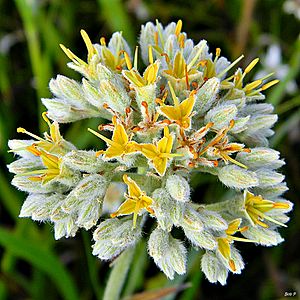Carolina redroot facts for kids
Quick facts for kids Carolina redroot |
|
|---|---|
 |
|
| Lachnanthes caroliniana | |
| Scientific classification | |
| Genus: |
Lachnanthes
|
| Species: |
caroliniana
|
| Synonyms | |
|
|
Lachnanthes is a type of plant that has only one species, called Lachnanthes caroliniana. People often call it Carolina redroot or bloodroot. It belongs to the bloodwort family. These plants are monocots, which means their seeds have one leaf when they sprout.
This plant grows naturally in eastern North America. You can find it from southeastern Nova Scotia and Massachusetts in the north, all the way south to Florida and Cuba. It also grows west along the Gulf of Mexico to Louisiana. It has even been seen on an island near Honduras in the western Caribbean.
Carolina redroot likes wet, acidic, and often sandy soils. This means it usually lives in places like bogs, pinelands, hammocks, and pocosins.
The plant gets its common names, "redroot" and "bloodroot," from its red roots and underground stems, called rhizomes. Its flowers are pale yellow and have six petal-like parts called tepals. They usually bloom in the middle to late summer. Sometimes, this plant can be a problem weed in farms that grow cranberrys.
Plant Names and History
Plants often have scientific names that can be a bit tricky. The name "Lachnanthes" is a special one in botany. This means that even if an older name existed, "Lachnanthes" was chosen to be the official name for this plant. This helps scientists around the world use the same name.
There were a few names that caused confusion:
- Heritiera Aiton, from 1789. This name was for a completely different tropical tree.
- Heritiera J.F. Gmelin, from 1791. Because the first Heritiera already existed for another plant, this second name was not allowed.
- Lachnanthes S. Elliott, from 1816. This is the name we use today.
Because of the special rule, the name "Lachnanthes" from 1816 is used for the plant we now call Lachnanthes caroliniana. This makes sure everyone knows which plant is being discussed.
Plant Family Tree
Scientists use DNA to understand how different plants are related. This is like creating a family tree for plants, which is called phylogeny. By comparing the DNA of different plants in the Haemodoroideae subfamily, we can see how they are connected.
The diagram below shows how Lachnanthes fits into its plant family. It helps us understand its close relatives.
| subfamily Haemodoroideae |
|
||||||||||||||||||
|
|||||||||||||||||||
See also
 In Spanish: Lachnanthes caroliniana para niños
In Spanish: Lachnanthes caroliniana para niños

